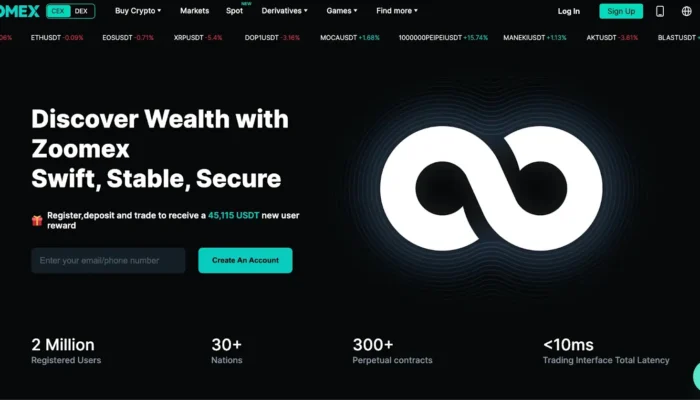The crypto sector has been undergoing massive changes in the last few months, with tokens driving up. With this, traders are flocking into the market to get a piece from the market’s profits. But while it looks like centralized tokens are stealing the show, decentralized tokens are also skyrocketing in value. This has pushed the majority of the traders in the market to the decentralized finance sector. The decentralized finance sector provides traders with several services, such as swapping and lending. With this, traders are open to various decentralized exchanges to carry out their activities. In this article, we will be looking at the major differences between PancakeSwap and SushiSwap.
-----Cryptonews AD----->>>Sign up for a Bybit account and claim exclusive rewards from the Bybit referral program! Plus, claim up to 6,045 USDT bonus at . https://www.bybit.com/invite?ref=PAR8BE
<<<-----Cryptonews AD-----
What is Decentralized Finance?
Decentralized Finance is a system that provides traders with financial services which are on different blockchains. This means that traders can carry out their services without the involvement of financial third parties. With that, traders are not required to submit any document for identification as sellers and buyers meet via a peer-to-peer system. To make this system possible, most decentralized exchanges in the sector make use of smart contracts. Facilitating smart contracts allows traders to communicate with the blockchain to carry out their respective services on the decentralized exchange.
What are Decentralized Exchanges?
Decentralized exchanges are the main embodiment of the decentralized finance sector. They are platforms that traders use to carry out their activities in the sector. Traders use decentralized exchanges to carry out various services such as swapping, lending, and borrowing via communication with smart contracts. Decentralized exchanges deploy their respective smart contracts, which can be used for different purposes. The highlight of the exchanges is that they allow traders to carry out their business without the need for registration, unlike centralized exchanges.
What is PancakeSwap?
PancakeSwap is a Binance Smart Chain-based decentralized exchange that was launched in September 2020. Traders in the platform can trade and swap any token of their choice using its liquidity pools. Like most decentralized exchanges in the sector, traders can effectively carry out their activities without the need for an intermediary.
PancakeSwap uses an Automated Market Marker, which relies on the usage of smart contracts to carry out transactions. PancakeSwap owns its liquidity pools called SYRUP pools, while its native token is called CAKE. The decentralized exchange is the go-to for traders who intend to enter the yield farming or staking business. Presently, PancakeSwap is ranked #2 on CoinMarketCap with a daily trading volume of $3,578,110,152.
Unique Features Of PancakeSwap
Traders who intend to use PancakeSwap to carry out their trading activities must connect a supported DEX wallet to the platform. PancakeSwap supports wallets such as Trust Wallet, Math Wallet, and the Binance Chain Wallet. However, traders who want to use the Ethereum based MetaMask wallet must first configure the wallet to work on the Binance Smart Chain network.
Users can provide liquidity on the platform by depositing funds into any liquidity pool they intend. In turn, the platform awards them rewards in its Liquidity Provider token. Traders who receive this LP token can either swap or trade them and take out their profit. The platform also allows users to carry out yield farming by staking tokens and harvesting them when ready for collection.
The rewards gotten from staking tokens depend on how long traders leave their tokens staked on the platform. Traders are can also enter the PancakeSwap lottery, where they can win provided they have at least one of the random numbers on the winning ticket. PancakeSwap also allows traders to win NFTs, which can be exchanged for CAKE tokens. Platforms that intend to carry out Initial Farm Offering can use the launchpad of the platforms to raise funds for their projects before they go live.
What is SushiSwap?
SushiSwap is a decentralized exchange located on Ethereum which was launched in August 2020. Like PancakeSwap, SushiSwap’s developers are pretty much unknown aside from being known as Chef Nomi, 0xMaki, and Sushiswap. Not long after it was launched, the pseudonymous developers gave out the exchange rights to Sam Bankman-Fried, the CEO of FTX.
The switch was completed after the FTX boss moved $1 million to SushiSwap from UniSwap. SushiSwap is presently occupying the #6 position on CoinMarketCap with a daily trading volume of $580,269,588. SushiSwap is also an Automated Market Marker, and the native token of the platform is called SUSHI.
Unique Features of SushiSwap
Sushiswap has a list of supported wallets that users can connect to before carrying out their activities. Users can use MetaMask wallet, Coinbase wallet, and Lattice to carry out transactions on the platform. SushiSwap allows traders to swap different kinds of tokens on the platform. For example, traders can choose to swap their USDC stablecoin for Ethereum.
Its native token, SUSHI, can be traded even outside the platform, with notable centralized exchanges listing it. Traders who intend to use the liquidity pools to earn rewards must deposit two or more pairs of equal amounts to the liquidity pools. SushiSwap also allows traders to earn rewards by staking the native token, SUSHI. Traders can choose to lend out tokens and get interests in return or borrow tokens with collateral. SushiSwap also allows new projects to launch on its platform through an open-source smart contract called Minimal Initial Sushiswap Offering.
Differences between PancakeSwap and SushiSwap
Sushiswap and PancakeSwap were both forked from Uniswap, which means they will generally have more similarities than differences. But this doesn’t come without the fact that they have differences. Traders who intend to carry out trading services would prefer one over another based on features that the other lacks.
PancakeSwap allows traders to pay less for transactions due to it being housed on the Binance Smart Chain. Meanwhile, due to congestion, Sushiswap, built on Ethereum, will cost traders more in terms of transaction fees. With this, traders pay as high as 0.3% as transaction fees on SushiSwap compared to the 0.2% that traders pay for transactions on PancakeSwap.
Another factor to work out is the popularity of the chains as Ethereum is used mostly by most developers while Binance Smart Chain is just coming up in the sector. Although both platforms allow traders to change the protocol if they hold their native tokens, this freedom is less on PancakeSwap. This is because, over the past couple of months, only the developers have made changes on the platform compared to SushiSwap, where the community holding the native token has been active.
Conclusion
One key takeaway from this article is that you will face a tough choice of picking between the two decentralized exchanges. This is because even though there are the same, the differences between them are negligible. However, it is safe to say that traders would prefer to carry out traders on a fast protocol that charges low fees than a popular decentralized exchange. However, you should note that it is great that you carry out your own research before anything. This is because research will keep you up to date with any changes that might have happened after this article.

The post PancakeSwap VS SushiSwap – What is the Difference? appeared first on CryptoTicker.
PancakeSwap VS SushiSwap – What is the Difference?




